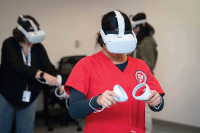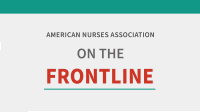By Sharon A. Morgan, MSN, RN, NP-C
The recent worldwide outbreak of Candida auris, a multidrug-resistant fungus, underscores the criticality of robust institutional and community- based antibiotic stewardship programs. Improving antibiotic use is a patient safety issue. As frontline healthcare providers, nurses can become more engaged and take a leadership role to enhance a facility’s antibiotic stewardship program. The nurse’s role with patient and family as the hub of communication among all stakeholders in antibiotic delivery puts nurses in a unique and vital position to optimize antibiotic use. Unfortunately, the nurse’s role in stewardship activities often goes unnoticed, even among nurses themselves.
These points are highlighted in a new white paper from the American
Nurses Association (ANA) and the Centers for Disease Control and Prevention (CDC), which details recommendations on how nurses can address this patient safety issue.
A call to action


In late 2015, ANA sought members to collaborate with the CDC to better define the role of bedside nurses in acute care hospitals’ antibiotic stewardship efforts. About 30 healthcare professionals were selected to serve on an expert advisory committee, which represented a diversity of geographic locations and expertise in acute care hospital settings. The workgroup held a series of virtual meetings, culminating in a 1-day in-person conference in July 2016. Attendees outlined key priorities: publish a joint position statement, identify and incorporate national nursing standards and metrics, identify educational gaps, and develop resources for nurses to seamlessly engage in hospital antibiotic stewardship programs.
Nurses already engage in stewardship activities, so the workgroup’s goal was to help codify and strengthen the role of nurses in antibiotic stewardship. To that end, the ANA/CDC Workgroup proposed that the ANCC Magnet Recognition Program® endorse two clinical indicators specifically related to antibiotic stewardship. As a result, methicillin-resistant Staphylococcus aureus and Clostridium difficile infections will be added as optional unit- or clinic-level nursing-sensitive clinical indicators beginning with the 2019 Magnet Application Manual, as noted in the white paper.
The ANA/CDC white paper
The first comprehensive snapshot of the problem was identified in the CDC report, “Antibiotic resistance threats in the United States, 2013.” Using conservative estimates, the CDC determined that each year more than 2 million Americans develop serious infections with bacteria that are resistant to one or more antibiotics, and at least 23,000 people die each year as a direct result of these infections. According to the CDC report, improving antibiotic use is one of the most important needs in reducing antibiotic resistance.
In the white paper, ANA and the CDC note a growing body of evidence that supports formalized stewardship programs as a viable avenue to decrease unnecessary exposure to antibiotics, improve infection cure rates, reduce adverse drug reactions, and slow the emergence of antibiotic resistance, with resultant significant cost savings for hospitals. To help hospitals implement antibiotic stewardship programs, in 2014 the CDC developed the core elements of hospital antibiotic stewardship programs, outlining seven components that have been linked with other successful programs. Using the tasks or activities identified by the core elements, the workgroup was able to align the tasks with current, common nurse functions, thereby underscoring the unrecognized nurses’ role in stewardship functions, the ANA-CDC white paper states.
While the ANA/CDC white paper is an excellent beginning, gaps exist in nurse perceptions of their roles in antibiotic stewardship initiatives. In nurse education, those gaps include microbiology and pharmacology, and in hospitals it’s the need to involve nurses in antimicrobial stewardship. More work is underway. That said, the ANA/CDC white paper provides a playbook that illustrates how nurses can incorporate antibiotic stewardship into their daily activities and how nurses can take a leadership role in defining a robust stewardship program.
Sharon A. Morgan is a senior policy advisor in Nursing Practice & Work Environment at ANA.
Read the ANA/CDC white paper on the nurse’s role in antibiotic stewardship.
October 2017 Frontline




















